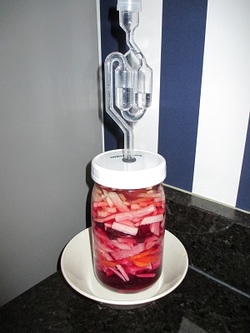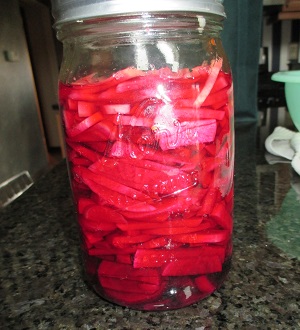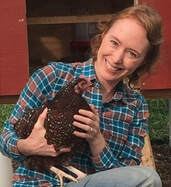Of course, this isn't just related to the health of our gut flora, but an overall neglect of our health as a holistic system, much to our detriment. Addressing symptoms (as modern medicine does) does little to nothing to correct the imbalances which caused these symptoms in the first place. It is akin to, as one of my favorite health writers often says, sticking a piece of masking tape over the "check engine" light on your car, and going on as if the problem is fixed. Eventually, whether it be 10, 20, or even 30 years down the road, things WILL fall apart - it's just a matter of time. Many of us are starting to experience this "falling apart" effect now, and wondering, "why now?," and "why me"? But that's a topic for another day! Stay tuned to this blog for more on maintaining comprehensive (or holistic) health, such as the article posted two weeks ago on the "systems model" of health.
Today, what I want to talk about is an important piece of that healthy system - in fact, maybe one of the most important pieces.... Those little bugs in your belly!
Here are just a few of the things beneficial bacteria have been known to do for you:*
- Aid & maintain proper digestion
- Improve absorption of nutrients from food and supplements
- Help maintain a healthy weight
- Prevent diabetes
- Maintain bowel regularity
- Help eliminate toxins from your body
- Slow or prevent the progression of diseases such as Parkinson's, Alzheimer's, multiple sclerosis, and others
- Minimize incidence of diseases such as Crohn's, colitis, C-Dif, irritable bowel, and related autoimmune and digestive disorders
Obviously these little "good guys" are pretty important for our health! And we are killing them daily with antibiotics, chlorinated water, and "antibacterial" everything. Is it any wonder our country has some of the unhealthiest people, and the highest healthcare costs?
So what can you do about it? Well, since the quick answer for everything is to pop a pill, you may notice probiotic supplements popping up everywhere. There are literally hundreds (if not thousands) of different probiotic supplements out there, all claiming to be "the best". How do you tell what's really the best? Beats me! I know I like the ones that I take - simply because they "keep me regular," and I know they are made in the US with quality, organic ingredients. But I don't know that they're necessarily a lot better than dozens of other similarly good formulations that are available. (I currently take Garden of Life's Primal Defense.)
But well before there were ever "probiotics" available on store shelves, humans have been supplementing their diets with healthy probiotic bacteria. The consumption of fermented foods goes back thousands of years, and I may be presumptuous in saying this, but it probably was instrumental in our survival as a species for so long! It is only within the past century that our modern, convenience-focused world has started phasing out fermented foods (and the huge increase in "first world diseases" seems to coincide... Coincidence?? Maybe....). Everything from condiments like ketchup and soy sauce, to pickles and sauerkraut, used to be fermented foods (almost none of them are anymore - even sauerkraut; to check if your sauerkraut is actually fermented - look for vinegar on the label. If it contains vinegar, it's probably not naturally fermented.) One of the few fermented foods that is regularly still consumed is yogurt, and even this is often processed after the cultures are added, rendering any bacterial content null and void.
Really, the only way to make sure you are getting live, quality probiotic bacteria is to grow it yourself. Got your petri dish ready? Just kidding! :-)
It's actually super easy to make your own probiotic foods! Yogurt is one of the easiest, and I make a batch almost weekly. (I use the Eurocuise Yogurt Maker and starter.) You can find lots of recipes for yogurt and other fermented foods in the absolutely awesome book (my healthy foods bible!), Nourishing Traditions, by Sally Fallon of the Weston Price Foundation.
But today I want to share with you my recipe for naturally fermented vegetables (I sometimes call it kimchi, but technically kimchi is made with cabbage, and although I have made it this way before, I usually do it without). This is one of the best sources for keeping your body's "good bacteria" strong, and maintaining your long-term health. You can create your own recipes too, once you get the hang of it, but I suggest sticking with this recipe, or one from Sally Fallon's book, at first, to ensure good results.
 Day 1: Set to ferment using The Perfect Pickler.
Day 1: Set to ferment using The Perfect Pickler. What You Will Need:
- A fermenting crock, OR a clean wide-mouth quart jar and an air-lock lid, such as The Perfect Pickler
- A large, sharp knife and clean cutting surface, or a mandoline slicer - preferred (you don't have to have one, but it makes things way easier and faster!)
- A clean kitchen towel
- A shallow dish in case of leakage (optional)
Ingredients:
- Approximately 4 cups of chopped firm, organic root vegetables (I vary mine sometimes, but this time I used beets, turnips, carrots, and daikon radish)
- 1 thumb-sized piece of fresh ginger
- 2-4 cloves fresh garlic (depending on how garlicky you want it)
- 1/4 tsp crushed red pepper (optional)
- 1 TB natural sea salt (I always use the minimally processed Celtic Sea Salt that comes with the Perfect Pickler)
- Approx. 2 cups bottled or distilled water (do NOT use tap water! The chlorine will kill all your good bacteria, and it will not be fun - trust me!)
What To Do:
- Scrub your vegetables with a brush, rinse well and let air-dry on a towel (remember, you don't want any remaining chlorine from the water on them).
- Peel if desired - I prefer not to, since all of mine are organic, and a lot of the good bacteria will be on the peel. I usually peel off just any rooty, scruffy looking areas, and leave the rest alone.
- Chop into small, uniform pieces (here is where the mandoline slicer is a lifesaver! It makes it go super fast, and everything comes out about the same size - just be careful - those suckers are sharp!!)
- Peel the ginger root, and grate, or slice thinly.
- Peel the garlic cloves and quarter them.
- Mix vegetables together if you like, or layer them into the jar like I did, packing them tightly into the jar (or crock) as you go. Add the garlic and ginger in between the layers.
- Add the sea salt to the 2 cups of water in a glass bowl or measuring cup, and stir until dissolved (this can take a while - it may help to add the salt to the water before chopping your vegetables - that way it will partly dissolve on it's own - give it a stir once in a while and by the time your veggies are ready the brine should be as well).
- Sprinkle the red pepper over the vegetables (if using), and pour the brine over, until full according to the directions on your crock or the Perfect Pickler.
- If using The Perfect Pickler, seat the overflow cup, put on the lid, tighten, and add your air-lock. (Set in a shallow dish in case of overflow if desired.) Otherwise follow instructions for your fermenting crock.
- Place your crock or jar in a dark place with fairly constant temperature - you want it to remain around 70-degrees Fahrenheit. It can be a little below, or a little above, but for best results, it should stay within a few degrees. If it is slightly cooler, it will take longer to ferment. If it is slightly warmer, it may be done sooner, so check it earlier.
- Let ferment for 4-5 days. I usually check it on Day 4, but for me it typically takes another day or sometimes even 2.
- On Day 4, remove the lid, and taste your pickles. If they do not taste sour enough, replace the lid snugly and let ferment another day, then re-taste until you are satisfied. (Note: Naturally fermented pickles will not have a strong sour taste like vinegar - it will be more of a mild tangy flavor. If you would like them to taste more classically sour, you may add a bit of vinegar after they are done fermenting, if you wish.)
- When done, remove the lid and airlock, and cap with a regular air-tight lid (if using a crock, transfer to a glass jar with tight-fitting lid). Refrigerate. Flavor will continue to develop in the refrigerator, and your pickles should keep for several months.
- Eat a small amount every day to maintain your bacterial flora - and your health!
Tip: If you use beets, I find it helps to tell when the pickles are done! At first - as in the picture on Day 1 above, you will see all the distinct colors of the vegetables. Each day the color from the beets will gradually start to permeate the jar. When they are ready, the entire jar will be pink - so you can hardly tell which pieces are the beets! (As in Day 5 picture below.)




 RSS Feed
RSS Feed